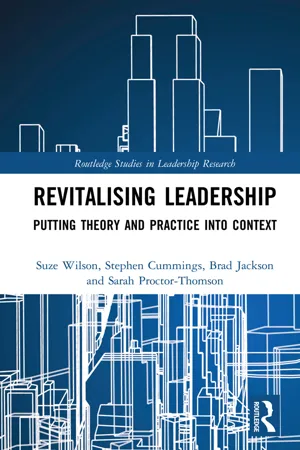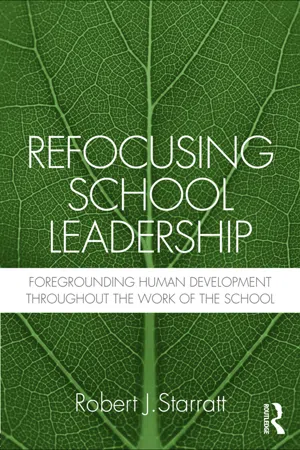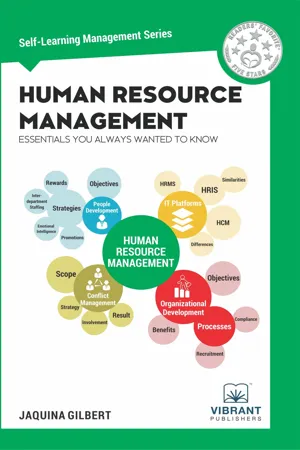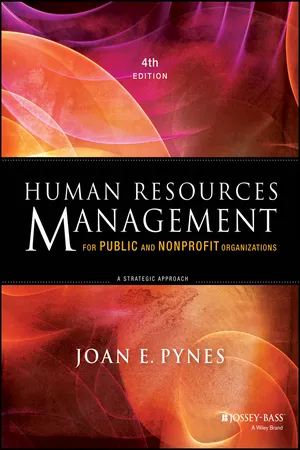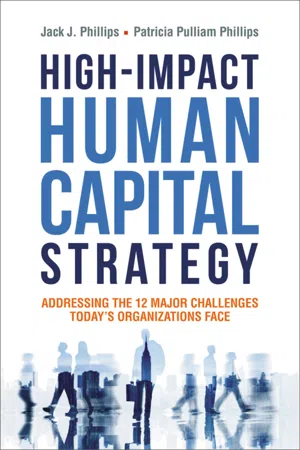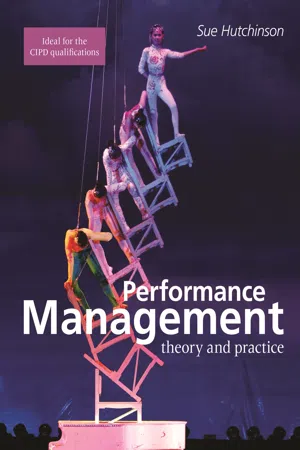Business
Importance of Leadership in Human Resource Management
Leadership in human resource management is crucial for driving organizational success. Effective leadership ensures that HR strategies align with business goals, fosters a positive work culture, and promotes employee engagement and development. Strong leadership also plays a key role in managing change, resolving conflicts, and driving innovation within the organization.
Written by Perlego with AI-assistance
Related key terms
11 Key excerpts on "Importance of Leadership in Human Resource Management"
- eBook - ePub
Revitalising Leadership
Putting Theory and Practice into Context
- Suze Wilson, Stephen Cummings, Brad Jackson, Sarah Proctor-Thomson(Authors)
- 2017(Publication Date)
- Routledge(Publisher)
Leading in Human Resource ManagementIntroduction
‘Human resource leadership’ is not necessarily a widely understood phenomenon. While formal roles and practices for managing human resources are by now ubiquitous across small, medium and large organizations, human resource management (HRM) has for many years struggled to assert itself (Wright, Dunford & Snell, 2001; Nkomo & Ensley, 1999). From a worker’s perspective, human resource managers are often more likely to be seen as untrustworthy agents for the shareholders than employee advocates and leaders. From an organizational perspective, HRM is regularly excluded from executive levels, and where granted organizational influence through strategic HRM approaches or otherwise, it has been accused of failing to deliver (Hammond, 2005; Bolton & Houlihan, 2007). Furthermore, while HRM has been framed as a means to develop leadership in others, it is far less likely to be seen as performing leadership itself.Increasingly, however, the status of HRM as a leadership function has emerged. In practice, there has for some time been a loud lament about the paucity of individuals who are adequately prepared to take up the ‘demanding’ and ‘visionary’ role of leading HRM in (especially) large organizations. It is likely, too, that many HR managers view themselves as performing leadership. Academic research, however, has been slow to follow suit. While extensive calls have been made by scholars for the recognition of HR as a strategic partner in organizations, there has been only minimal consideration of the nature of leadership in such strategic roles (although see Caldwell, Truong, Linh & Tuan, 2011). Indeed, the extensive scholarly fields of HRM and leadership studies have developed largely independently (Den Hartog & Boon, 2013), and at the time we were preparing this chapter, a call for papers was circulating for a special issue of Human Resource Management Review - eBook - ePub
- Meyer M, Krüger-Pretorius(Authors)
- 2018(Publication Date)
- Van Schaik Publishers(Publisher)
As a future or maybe even a current HR manager, it is important to understand what is required from you as a manager. Even though not all managers are deemed to be leaders, leadership remains a component of the management process. As such, it is important to know what leadership means and what it entails. This chapter introduces both these concepts, i.e. management and leadership, considering the main functions and fundamental skills managers and leaders require, and the significance of emotional intelligence.Depending on their personality, managers can adopt different styles of leadership with the ultimate aim of motivating individual employees to work together to achieve the goals and objectives of the organisation. We therefore look at six leadership styles and identify which ones could possibly work better in the 21st century. We also introduce four motivational theories or models. We discuss the role of ethics in leadership and end with how you, as an HR professional within the HR function, can plan and evaluate your own leadership.9.2 The differences between a manager and a leader
Management and leadership are two distinct yet complementary sets of management activities – “[a] person can be a manager, a leader, both, or neither” (Griffin, Phillips & Gully, 2017; Smit, Cronje, Brevis & Vrba, 2011).As an HR manager in a management role, you will be expected to fulfil the main functions of any manager. Management functions are also sometimes referred to as management tasks or management activities. A manager is considered to be a person who applies the basic management functions of planning, organising, leading and controlling (Griffen, 2013). By doing so, a manager ensures that organisational rules and procedures are followed and that systems in an organisation are maintained. - eBook - ePub
Refocusing School Leadership
Foregrounding Human Development throughout the Work of the School
- Robert J. Starratt(Author)
- 2010(Publication Date)
- Routledge(Publisher)
CHAPTER 4 Human Resource Leadership Within Its Organizational SettingIntroduction
In this chapter, we consider the setting for human resource development, namely, the organization in which human resources are nested. Obviously, the development of human resources would differ within the organizational arrangements of a hospital, a prison, a military base, a bank. Those different settings would reflect different horizontal and vertical operational procedures, policies, communication networks, systems of authority, diversification of roles, accountability systems, support functions, and so forth. Human resource development in schools and school systems, while conforming to very general principles of human resource development, serves the purposes and institutional identities of schools. In this chapter, we shall consider some large conceptual and metaphorical frameworks for understanding how schools as organizations function and explore the implications for those with human resource development responsibilities.Human Resources as the Life Blood of Organizations
When considering the biology of a human body, we can see how important is the circulation of blood to its life and functioning. The blood carries nutrients and chemicals to various parts of the body. When the brain is deprived of blood it gradually ceases to function; similarly for the lungs and digestive system. All the body’s tissue and bone structure requires blood to give them life and strength. So, too, it is difficult to conceive of an organization without people inside the organization who carry the energy, the oxygen and nutrients that enable it to function. Schools as organizations cease to be schools without students and teachers, and—given the complexity of present day school systems—without the support staff of secretaries, counselors, computer technicians, maintenance and cafeteria personnel, central office support staff, and others. The presence of these “human resources” enables schools to function as organizations. The organization charts, the curriculum and daily schedule, the budgeting and accounting systems, the communication technologies—these are all important factors in the organizational life of schools. Without the humans who construct and enact these organizational features, however, schools as functioning organizations cease to exist. That is why we began our journey into human resource management and development with a grounding in the human in all its complex potential. That is the perspective we can never ignore in leading the development of human resources. - eBook - ePub
- Susan Miller(Author)
- 2011(Publication Date)
- SAGE Publications Ltd(Publisher)
Following this the debate around the difference between personnel management and HRM is described. The chapter then proceeds to identify some of the approaches that have been advanced which link HRM and organizational performance and to analyze the nature of the employment relationship. The latter includes a short discussion of the main perspectives on the employment relationship. This is followed by an overview focussed on the character of the employment relationship. Finally, there is a short discussion of some critical commentaries on HRM. The Importance of Human Resource Management Human Resource Management (HRM) as an area of managerial practice continues to evolve and change. This is, in part, due to its situated nature within an external context comprising those economic, political, technological, social and environmental influences which affect organizations and the people who work within them. This has of course been particularly pronounced over the last few years as the global financial crisis has had a profound effect – for example, on the numbers of people employed in organizations, on the regulatory responses by government which can impact on how people are managed, on the pay and rewards which individuals receive and on individuals’ feelings of job security. More broadly the last couple of decades have been characterized as a period of globalization in which we have seen changes in terms of scale and interdependency (Morgan, 2010). This has impacted on business in a number of ways. For example, Brawley (2003) claims that economic globalization has resulted in a number of significant changes - Vibrant Publishers(Author)
- 2020(Publication Date)
- Vibrant Publishers(Publisher)
“The human mind is our fundamental resource.” This suggests that in a situation where there is a tangled relationship between an employer and the employee, the affairs of the business would be affected. In this case, the concept of Human Resource Management brings about a balanced relationship between employers and employees.Training and Development of EmployeesFor better company performance, workers must be qualified, skilled, and trained. Either the worker is allowed to adapt to the system or is trained to develop at a faster pace. Allowing a worker to adapt naturally would cost time and generate ineffective yields. However, training such individuals would aid the organization significantly.1.5 The Human Resource ManagerHuman Resource Management comprises a human member or members. Human resource managers are responsible for the supervision, controlling, procurement, and management of human resources. They are the link between employers and employees, and they often validate decisions pertaining to the human resourcefulness of an organization.The human resource manager position is a professional type. It requires the psychological ability to handle situations proactively and reactively. Decisions are incredibly impactful and can either leave a blemish or create a sound, consistent practice for the company. Moreover, some of the conventional qualities of human resource managers include oratorical prowess, an actively thinking mind, the ability to dissolve pressure, excelled communication skills, and, most importantly, excellent leadership skills. All of these are put together for the description of human resource managers.Some Responsibilities of the Human Resource ManagerHuman resource managers are tasked with hefty responsibilities, especially that they act as a decisive measure for the productivity of a company. However, a competent and skilled human resource manager should possess at least the following attributes and be able to perform the following functions:- eBook - ePub
Human Resources Management for Public and Nonprofit Organizations
A Strategic Approach
- Joan E. Pynes(Author)
- 2013(Publication Date)
- Jossey-Bass(Publisher)
To be strategic partners, HRM departments must possess high levels of professional and business knowledge. HRM must establish links to contribute to organizational performance and be able to demonstrate on a continuing basis how HRM activities contribute to the success and effectiveness of the organization.A report by the Society for Human Resource Management (2010a), What Senior HR Leaders Need to Know: Perspectives from the United States, Canada, India, the Middle East and North Africa , identified eighteen core senior HR leadership competencies:- Business knowledge: An understanding of the operations and processes of how business is conducted
- Coaching/developing others: Helping others to reach their potential
- Credibility: Being perceived by others as having the knowledge and experience to back up one’s authority
- Critical/analytical thinking: Seeking information and using that information to inform decisions and resolve problems
- Cross-cultural intelligence: Knowledge of and sensitivity to differences among cultures
- Effective communication: Being able to verbally or in writing convey messages in terms that make sense and also to listen closely to what others are saying
- Ethical behavior: Perception of the moral appropriateness of individual or group conduct or behavior
- Flexibility/adaptability: The ability to adjust the approach as required by shifts within the organization and in the external business environment
- Global intelligence/global mind-set:
- eBook - ePub
- Jack Phillips, Patricia Phillips(Authors)
- 2015(Publication Date)
- AMACOM(Publisher)
2THE IMPORTANCE OF HUMAN CAPITAL STRATEGY AND THE ROLE OF THE CHIEF HUMAN RESOURCES OFFICER
T he first step in examining the ability of the CHRO to create value for an organization is to revisit the strategy. This chapter explores a variety of issues involved in linking human resources to the strategy of the organization and includes current trends, processes, and successes. The focus throughout this chapter is how to develop a human capital strategy to create value, drive results for the organization, and prepare for the forces influencing organizations.The Importance of Linking Human Resources to Strategy
Connecting HR to strategy has been a developing trend for many years. Human resources was originally initiated in organizations because business strategy determined that HR was necessary. The level of CHRO participation in the corporate strategic planning process has been increasing, and there is evidence to suggest that the CHRO’s role as strategic planner will be increasingly important in the years to come.1 This conclusion is based on how CHROs respond to five basic questions that surround the strategic planning process:1. What is our business? 2. What will our business be? 3. What should our business be? 4. What forces will influence our success? 5. How will we address these forces?Human resources is an important part of framing the appropriate responses to these questions. The CHRO, as part of top management’s strategic planning effort, can provide the knowledge and vision necessary to make decisions and take action that will provide employees the opportunity to achieve success.HR is being completely transformed in many organizations. The result is the creation of strategic, value-added, critical business processes within the organization. To achieve value, the human capital function is creating business results, assisting in strategy implementation, and helping in strategy formulation. - eBook - ePub
- Juani Swart, Clare Mann, Steve Brown, Alan Price(Authors)
- 2012(Publication Date)
- Routledge(Publisher)
The final section looks at how some firms have developed a set of best practices, thus enabling reconfiguration in order to improve performance in innovation, quality and other important competitive variables. We will explain some of the key requirements in developing best practice in human resource development, and how firms have had to reconfigure themselves – which can only be done as part of wider human resource development.Objectives By the end of this chapter you will be able to: • Appreciate why human resource development is of strategic importance in the current business world • Realize how human resource development has changed over time • Understand why some firms have problems in viewing human resources in a strategic manner • Have a basic insight in the key areas that will then be explored further in subsequent chapters.The Strategic Importance of Human Resource Development Why People are Important in OrganizationsIt should be self-evident: organizations consist of people, and so the development of these people should be a key task for organizations. If you were to speak to senior-level managers within firms they would, typically, state how important their staff are. Sadly, however, these same senior-level managers will often concentrate on slashing budgets related to human resource development. They may also have no qualms about downsizing the number of employees at the same time. What is sometimes not clear, though, is that people really do matter in organizations. People matter because in the highly competitive environment which firms now face, human capital has become a precious commodity in gaining any sort of advantage over other firms. The following states it succinctly:A culture that values curiosity is inventive and exciting. Walk into the headquarters of USA in San Antonio, Texas, 3M in St Paul, Minnesota, or Lockheed Martin in Fort Worth, Texas, and you can feel the heat of originality cooking in the organizational oven. What you later learn is that you’re in a place with an everlasting focus on perpetual growth. The popular label for such an environment is a learning organization. A more accurate description is a discovering organization. The term learning can imply the act of adding to or increasing what’s already there; discovering means uncovering or finding. Learning can happen through osmosis, in which you’re passively the recipient of growth, without much effort. Discovering suggests an active search and a deliberate exploration. - eBook - ePub
Human Resource Management in Education
Contexts, Themes and Impact
- Justine Mercer, Bernard Barker, Richard Bird(Authors)
- 2010(Publication Date)
- Routledge(Publisher)
Part I The current context of human resource managementPassage contains an image
1 Introduction
Globalization, human capital theory and human resource managementIntroduction
This book provides an holistic, research-based overview of the core ideas and key debates in human resource management (HRM) within the education sector. It has been written to help practitioners, students and academics develop an appropriate conceptual framework within which to situate their own research and investigations. To this end, rather than simply reviewing the existing literature, it blends advocacy and evidence to offer readers a clearly articulated critical stance. It challenges the normative best-practice paradigm that dominates the field of HRM in education, and in its place develops a consistent alternative perspective that takes full account of recent national and international trends.The book argues that previous models of HRM are inadequate to address the issues educational leaders currently face. Whereas leaders in the past were able to gain support and satisfy stakeholders simply by treating people well, today’s leaders have to go beyond the principles of humane and equitable management practices because of very significant global shifts in economic patterns, government education policies, societal values and teaching cultures. To succeed in the twenty-first century, educational leaders need a thorough understanding of these global shifts and their implications. That in itself is not enough, however. Twenty-first-century educational leaders also need to view these trends and policies through a critical lens, constantly questioning the assumptions being made and interrogating the evidence being offered. Only then will they be able to ameliorate the worst excesses of a market-driven education system obsessed with spurious standards, and realize the full potential of education. The primary purpose of this book is to provide readers with just such a critical lens. - eBook - ePub
Workforce Inter-Personnel Diversity
The Power to Influence Human Productivity and Career Development
- Claretha Hughes(Author)
- 2019(Publication Date)
- Palgrave Macmillan(Publisher)
Aligning the needs of organizations and people is a central focus within the human resource frame as HR professionals seek to help strengthen the employee–organization bond. Organizations have to determine their purpose prior to determining the extent to which they need people. Once they determine how many people they need and why, human resource strategies become important. However, human resource personnel must align their efforts with management strategies. HR professionals seek to help the organization provide job security for their employees by establishing structures that allow promotion from within and training and development. They can use these skills to expand workforce inter-personnel diversity and subsequently improve the quality of work life (Katz, Kochan, & Gobeille, 1983 ; Ketsi, 2012) for the employees. It takes a desire for structural change for this idea to be successful. Leaders who operate in the human resource frame support employee participation, job enrichment, teaming, and promote diversity. They accept that employees bring social and personal needs to the workplace and that not all employees’ social skills or competencies are the same. Social skills and competencies are a critical element of employee performance especially within groups. However frustrating groups can be when social skills are so diverse, they can create more efficiency for the organization. Operating from the human resource frame alone comes with some risks. One risk is that human beings are all good to work with. This can be deceiving especially if a leader does not have DQ and overlooks mistreatment of protected class groups in the workplace. Leaders in this frame cannot be too optimistic about trust and win-win in high-conflict/high-scarcity situations (Bolman & Deal, 2008) - eBook - ePub
Performance Management
Theory and Practice
- Susan Hutchinson(Author)
- 2013(Publication Date)
- CIPD - Kogan Page(Publisher)
et al, 1997; Hales, 2005; Hutchinson and Purcell, 2010; Fenton-O’Creevy, 2001). More recently, the drive for cost efficiencies (eg the reduction in HR headcount) and improvements in service quality have also influenced this transition (Hutchinson and Tailby, 2012).CRITICAL REFLECTION 4.1
Discuss the view that in devolving HR activities to the line, the HR function is distancing itself from employees and losing contact with the human side of its work. You may like to read the journal articles by Francis and Keegan (2006) and Keegan and Francis (2010), who develop these points further in relation to the HR business partnering model.THE LINE MANAGER’S CRITICAL ROLE IN MANAGING AND LEADING PEOPLE
Chapter 1 introduced the evidence that line management behaviour is fundamental to delivering the performance benefits of good HR policies. As ‘HR agents’ of the organisation, line managers can significantly influence employee job satisfaction, commitment and discretionary behaviour by the way in which they implement and enact HR policies and show leadership (Truss, 2001; Purcell et al, 2009). Indeed, ‘poorly designed or inadequate HR policies can be “rescued” by good management behaviour in much the same way as “good” HR practices can be negated by poor front-line manager behaviour or weak leadership’ (Purcell and Hutchinson, 2007: 4). Front-line managers, in particular (ie those at the lower levels of the management hierarchy), have the potential to have the greatest impact on employees since they tend to have the bigger teams to manage and because of their proximity and regular interaction with employees (Becker et al, 1996). The research undertaken by Purcell and others (Purcell et al
Index pages curate the most relevant extracts from our library of academic textbooks. They’ve been created using an in-house natural language model (NLM), each adding context and meaning to key research topics.
